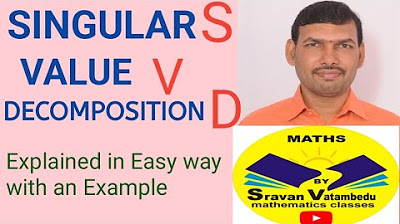Singular Value Decomposition (SVD) and Image Compression
Summary
TLDRIn this video, Luis Giserano explores Singular Value Decomposition (SVD) and its application in image compression. He explains the foundational concepts of SVD, demonstrating how it decomposes a matrix into singular values and vectors. Through a practical example involving a heart image, Luis shows how to compress the image by reconstructing it using outer products of the decomposed matrices, adjusting the sharpness based on the number of singular values retained. The video highlights the balance between image quality and storage requirements while encouraging viewers to delve deeper into related dimensionality reduction techniques and machine learning.
Takeaways
- 😀 Singular Value Decomposition (SVD) is a powerful mathematical tool used in data science and machine learning for dimensionality reduction.
- 🧮 SVD decomposes a matrix into three components: U, Sigma, and V dagger, allowing for simplified data representation.
- 📊 The decomposition results in the ability to capture important features in data while discarding less significant ones.
- 💻 In image compression, SVD can effectively reduce the size of image data while preserving essential visual information.
- 🖼️ The example used in the video illustrates how a heart image can be compressed by adjusting the components derived from SVD.
- 🔍 Different tools may produce slightly different SVD results, but the core components are consistent and can be manipulated for various applications.
- 🌈 Each component derived from SVD contributes to the overall image, with the first components having the most significant impact on visual quality.
- 📉 As more components are added for reconstruction, the image quality improves, but this also requires more storage space.
- 📚 The video encourages viewers to explore other dimensionality reduction techniques such as matrix factorization and principal component analysis.
- 🔗 The presenter also promotes their book on machine learning, highlighting its practical examples and Python code to enhance learning.
Q & A
What is Singular Value Decomposition (SVD)?
-SVD is a mathematical technique used to decompose a matrix into three other matrices, capturing its essential features. It allows for dimensionality reduction and is applicable to matrices of any shape.
How does SVD apply to image compression?
-In image compression, SVD can reduce the size of an image by approximating it with lower-rank matrices derived from its decomposition. This enables the storage of images with less detail while maintaining recognizable features.
What role do the matrices U, Σ, and V† play in SVD?
-In SVD, matrix U contains the left singular vectors, Σ is a diagonal matrix containing singular values that represent the significance of each component, and V† (the conjugate transpose of V) contains the right singular vectors.
What is the significance of the singular values in SVD?
-Singular values indicate the importance of their corresponding singular vectors in reconstructing the original matrix. Larger singular values contribute more to the overall structure and features of the matrix.
How are the components of the image obtained from SVD?
-Components of the image are obtained by calculating outer products of the corresponding columns from U and rows from V†, multiplied by the corresponding singular values from Σ.
What happens to the image quality as more singular values are included?
-As more singular values are included in the reconstruction of the image, the image quality improves, resulting in sharper images. However, this requires more storage space.
Why might some singular values be zero?
-Zero singular values indicate that certain components do not contribute to the matrix's rank, and thus, they do not affect the reconstruction of the image. These components can be ignored without losing significant information.
What are the trade-offs involved in using SVD for image compression?
-The trade-offs involve balancing image quality and storage space. Higher quality images require more singular values and therefore more storage, while lower quality images can save space by using fewer components.
What is the primary purpose of the GitHub repository mentioned in the video?
-The GitHub repository, 'singular value decomposition' by Luis Serrano, provides code examples and tools for performing SVD, enabling users to follow along and apply the technique to their own data and images.
What other topics does the speaker suggest exploring related to SVD?
-The speaker suggests exploring related topics such as matrix factorization and principal component analysis (PCA), both of which are also techniques for dimensionality reduction.
Outlines

Esta sección está disponible solo para usuarios con suscripción. Por favor, mejora tu plan para acceder a esta parte.
Mejorar ahoraMindmap

Esta sección está disponible solo para usuarios con suscripción. Por favor, mejora tu plan para acceder a esta parte.
Mejorar ahoraKeywords

Esta sección está disponible solo para usuarios con suscripción. Por favor, mejora tu plan para acceder a esta parte.
Mejorar ahoraHighlights

Esta sección está disponible solo para usuarios con suscripción. Por favor, mejora tu plan para acceder a esta parte.
Mejorar ahoraTranscripts

Esta sección está disponible solo para usuarios con suscripción. Por favor, mejora tu plan para acceder a esta parte.
Mejorar ahoraVer Más Videos Relacionados
5.0 / 5 (0 votes)






